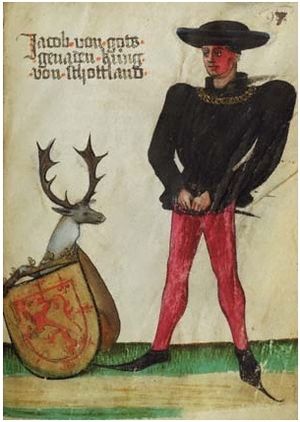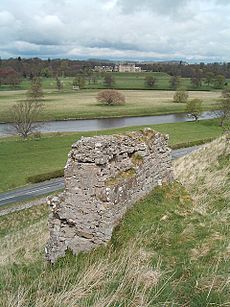James II of Scotland facts for kids
Quick facts for kids James II |
|
|---|---|

Contemporary image of the king, showing his distinctive facial birthmark
|
|
| King of Scots | |
| Reign | 21 February 1437 – 3 August 1460 |
| Coronation | 25 March 1437 |
| Predecessor | James I |
| Successor | James III |
| Born | 16 October 1430 Holyrood Abbey, Scotland |
| Died | 3 August 1460 (aged 29) Roxburgh Castle, Roxburghshire, Scotland |
| Burial | Holyrood Abbey |
| Spouse | |
| Issue more... |
|
| House | Stewart |
| Father | James I of Scotland |
| Mother | Joan Beaufort |
James II (born 16 October 1430 – died 3 August 1460) was the King of Scots from 1437 until his death. He was the oldest surviving son of James I of Scotland. James became king at just six years old after his father was killed. He was the first Scottish king not to be crowned at Scone. His coronation happened at Holyrood Abbey in March 1437. His time as king was marked by struggles to keep control of his country. He died in 1460 when a cannon exploded during a battle at Roxburgh Castle.
Contents
Becoming King: James II's Early Life
James was born at Holyrood Abbey in Scotland. His parents were King James I and Joan Beaufort. James had an older twin brother named Alexander, but Alexander died before James's first birthday. This made James the next in line to the throne, known as the Duke of Rothesay.
On 21 February 1437, King James I was killed. The six-year-old James immediately became King James II. He was crowned king at Holyrood Abbey on 23 March 1437. His mother, Queen Joan, was hurt during the attack on his father but managed to reach her son.
The Young King and His Guardians
After his father's death, James lived with his mother and five of his sisters at Dunbar Castle. His oldest sister, Margaret, had already gone to France to marry the future King Louis XI of France.
From 1437 to 1439, James's cousin, Archibald Douglas, 5th Earl of Douglas, led the government as the king's chief helper. After Archibald died, there weren't many strong leaders in Scotland. Power was then shared between William Crichton, 1st Lord Crichton, who was the country's top legal officer, and Sir Alexander Livingston of Callendar. Livingston was in charge of the young king and kept him at Stirling Castle.
In 1439, Livingston put Queen Joan and her new husband under house arrest at Stirling Castle. They were released after agreeing that James would stay with the Livingstons.
The Black Dinner
In 1440, a sad event known as "the Black Dinner" happened. The 16-year-old William Douglas, 6th Earl of Douglas, and his 12-year-old brother, David, were invited to Edinburgh Castle. They were guests at the king's table. Even though James was a small child and liked them, the Douglas brothers were taken and executed. Their supporter, Malcolm Fleming, also suffered the same fate. The young king had no part in this terrible act.
James II's Rule: Taking Control
In 1449, James II turned 18, which meant he was old enough to rule on his own. He had to work hard to gain full control of his kingdom. The powerful Douglas family helped him remove the Livingstons from power. This was partly revenge for his mother's arrest and the deaths of his young Douglas cousins, in which Livingston was involved.
However, the Douglases and Crichton still held much power. James had to fight to free himself from their influence. From 1451 to 1455, he worked to reduce the Douglases' power. This struggle ended with the death of William Douglas, 8th Earl of Douglas, at Stirling Castle in February 1452.
The Douglas Conflict
The main story of Douglas's death comes from an old record called the Auchinleck Chronicle. It says that King James accused the Earl of Douglas of making secret agreements with other powerful lords. This alliance would have been a big threat to the king's authority. When Douglas refused to break these ties, James became very angry. He attacked Douglas, stabbing him many times. Other officials then joined in.
This event did not stop the Douglases' power right away. Instead, it led to a period of fighting between 1452 and 1455. James tried to take over the Douglas lands, but the Douglases often forced him to give them back.
However, James started giving lands and titles to people who had been allies of the Douglases. This caused many of them to switch sides. In May 1455, James finally defeated the Douglases at the Battle of Arkinholm.
After this victory, the Scottish Parliament declared that the vast Douglas lands would belong to the crown forever. The Earl of Douglas fled to England. James finally had the freedom to rule as he wished. Future Scottish kings never faced such a strong challenge to their power again.
An Active King
Between 1455 and 1460, James II was a very active king. He had big plans to take over islands like Orkney, Shetland, and the Isle of Man, but these plans did not succeed. The king traveled around the country. Some historians believe he started the practice of raising money by forgiving people for serious crimes.
In 1458, the Parliament asked the king to change some of his behaviors. We don't know how his rule would have changed if he had lived longer.
James II is the first Scottish king for whom we have a picture from his own time. It's a woodcut that shows the birthmark on his face.
Marriage and Family
Discussions for James to marry Mary of Guelders began in 1447. The marriage was finalized in September 1448. Mary's great-uncle, Philip the Good, Duke of Burgundy, gave her a large sum of money. Her dowry, which was money or property brought by a bride to her marriage, was secured on lands in Scotland.
The wedding took place at Holyrood Abbey on 3 July 1449. A French writer described the ceremony and the feasts that followed. Many people from Mary's home country, Flanders, stayed in Scotland. This made the friendship between Scotland and Flanders even stronger.
The king's marriage also meant he was now fully in charge, and the Livingstons, who had controlled him, lost their power. In the autumn, Sir Alexander Livingston and other family members were arrested. Some were executed.
The King's Death
James II was very interested in modern artillery, which are large guns like cannons. He used them successfully against the Black Douglases. To increase Scotland's power, he decided to attack Roxburgh Castle in 1460. This was one of the last Scottish castles still held by the English after the Wars of Scottish Independence.
For this attack, James brought many cannons from Flanders. On 3 August, he was standing near one of these cannons when it exploded. The explosion killed him instantly. A historian named Robert Lindsay of Pitscottie wrote that "as the King stood near a piece of artillery, his thigh bone was dug in two with a piece of misframed gun that brake in shooting, by which he was stricken to the ground and died hastily."
The Scots continued the attack, led by George Douglas, 4th Earl of Angus. The castle fell a few days later. Once the castle was captured, James's wife, Mary of Guelders, ordered it to be destroyed. James's son became King James III, and Mary ruled as regent until her own death three years later.
James II's Children
James married Mary of Guelders at Holyrood Abbey on 3 July 1449. They had seven children:
- An unnamed son (born and died 19 May 1450)
- James III (born 10 July 1451 – died 11 June 1488): He became the next King of Scots.
- Mary Stewart, Countess of Arran (born 13 May 1453 – died May 1488): She married twice.
- Alexander, Duke of Albany (born around 1454 – died 7 August 1485)
- David, Earl of Moray (born around 1455 – died before July 1457)
- John, Earl of Mar and Garioch (born around 1456 – died around 1479)
- Margaret (born between 1453 and 1460 – death date unknown)
James also had one son from another relationship:
- John Stewart, Lord of Sticks (died 21 September 1523).
James II in Stories
James II has appeared in many plays and historical novels. Here are a few examples:
- The Captain of the Guard (1862) by James Grant: This novel covers events from 1440 to 1452, focusing on James II's conflict with the Douglas family.
- Two Penniless Princesses (1891) by Charlotte Mary Yonge: James II is a smaller character here. The story is about his sisters, Eleanor, Mary, and Joan.
- The Black Douglas (1899) by Samuel Rutherford Crockett: This book and its sequel, Maid Margaret, cover James II's reign from 1439 to 1460. They feature his struggles with the Douglas family, including the death of the 8th Earl of Douglas and James's own death by cannon.
- James II: Day of The Innocents (2014) by Rona Munro: This play is part of a series called The James Plays. It focuses on James II's early life and his relationships with the Douglas family.
- The Lion's Whelp (1997) by Nigel Tranter: This book describes James II's time as a boy king under his guardians and the "Black Dinner" event.
- Black Douglas (1968) by Nigel Tranter: This novel covers events up to the killing of the 8th Earl of Douglas.
- Niccolò Rising (1986) by Dorothy Dunnett: This book mentions James II's political actions as part of the wider European scene.
- In the Keep of Time (1977) by Margaret J. Anderson: This children's fantasy novel features James II as a background character. It describes his birthmark and the cannon explosion that killed him.
Images for kids
-
James II died outside the walls of Roxburgh Castle when one of his bombards exploded.
|
James II of Scotland
Born: 16 October 1430 Died: 3 August 1460 |
||
| Regnal titles | ||
|---|---|---|
| Preceded by James I |
King of Scots 1437–1460 |
Succeeded by James III |
| Peerage of Scotland | ||
| Preceded by Alexander |
Duke of Rothesay 1430–1437 |
Vacant
Title next held by
James (III) |
See also
 In Spanish: Jacobo II de Escocia para niños
In Spanish: Jacobo II de Escocia para niños






